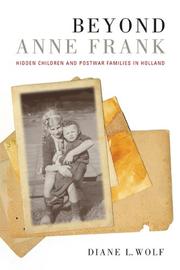| Listing 1 - 4 of 4 |
Sort by
|
Book
Year: 2011 Publisher: Boston : Academic Studies Press,
Abstract | Keywords | Export | Availability | Bookmark
 Loading...
Loading...Choose an application
- Reference Manager
- EndNote
- RefWorks (Direct export to RefWorks)
A survivor of concentration camps and the Death March, Eli Pfefferkorn looks back on his Holocaust and post-Holocaust experiences to compare patterns of human behavior in extremis with those of ordinary life.
Book
Year: 2012 Publisher: Boston, Massachusetts : Academic Studies Press,
Abstract | Keywords | Export | Availability | Bookmark
 Loading...
Loading...Choose an application
- Reference Manager
- EndNote
- RefWorks (Direct export to RefWorks)
Memoirs of a Jew born in 1931 in Ostrowiec Świętokrzyski, Poland. The town was occupied by the Germans in 1939, and in spring 1941 Rubin and his family were interned in the ghetto. Most of the family survived the large roundup of October 1942, when ca. 10,000 Jews were deported to Treblinka. In early 1943 there were rumors that the ghetto would be transformed into a labor camp, and Rubin decided to escape from the ghetto with a group of friends. Many of those who fled with him were betrayed by Poles or killed by the Armia Krajowa. After hiding for a short time at a nearby brick factory, Rubin was forced to enter a labor camp where his father and brothers were working. In December 1943 he escaped and fled to Warsaw, where his sister Fela lived under an "Aryan" identity. After many vicissitudes, including an encounter with blackmailers and an arrest, Rubin and Fela were liberated in January 1945 by the Soviets. Rubin's two brothers survived Mauthausen; his mother survived Auschwitz and Ravensbrück. After the war, Rubin settled in England. (From the Bibliography of the Vidal Sassoon International Center for the Study of Antisemitism - The Hebrew University of Jerusalem).
Holocaust, Jewish (1939-1945) --- Jewish children in the Holocaust --- Katz, Rubin,
Book
ISBN: 1512600784 1512600091 1512600113 1512600105 Year: 2017 Publisher: Waltham, MA, USA Brandeis University Press
Abstract | Keywords | Export | Availability | Bookmark
 Loading...
Loading...Choose an application
- Reference Manager
- EndNote
- RefWorks (Direct export to RefWorks)
This book offers an extensive introduction and 13 diverse essays on how World War II, the Holocaust, and their aftermath affected Jewish families and Jewish communities, with an especially close look at the roles played by women, youth, and children. Focusing on Eastern and Central Europe, themes explored include: how Jewish parents handled the Nazi threat; rescue and resistance within the Jewish family unit; the transformation of gender roles under duress; youth's wartime and early postwar experiences; postwar reconstruction of the Jewish family; rehabilitation of Jewish children and youth; and the role of Zionism in shaping the present and future of young survivors.Relying on newly available archival material and novel research in the areas of families, youth, rescue, resistance, gender, and memory, this volume will be an indispensable guide to current work on the familial and social history of the Holocaust.
Jewish families --- Jewish children in the Holocaust. --- Holocaust survivors. --- History --- Survivors, Holocaust --- Victims --- Holocaust, Jewish (1939-1945) --- Families, Jewish --- Jews --- Families --- Judaism --- Kibbutz --- Poland --- The Holocaust

ISBN: 9780520248106 0520248104 Year: 2007 Publisher: Berkeley University of California press
Abstract | Keywords | Export | Availability | Bookmark
 Loading...
Loading...Choose an application
- Reference Manager
- EndNote
- RefWorks (Direct export to RefWorks)
Hidden children (Holocaust) --- Holocaust survivors --- Holocaust, Jewish (1939-1945) --- Jews --- Geschiedenis van opvoeding en onderwijs --- Persecutions --- handboeken en inleidingen. --- Survivors, Holocaust --- Victims --- Children, Hidden (Holocaust) --- Jewish children in the Holocaust --- Netherlands --- Ethnic relations.
| Listing 1 - 4 of 4 |
Sort by
|

 Search
Search Feedback
Feedback About UniCat
About UniCat  Help
Help News
News